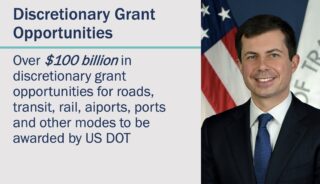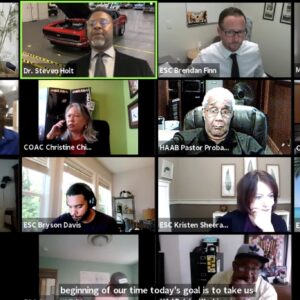
(Photo: Jonathan Maus/BikePortland)
A new infrastructure bill from the White House with a significant amount of new infrastructure funding finally passed on Friday afternoon. Of the $1.2 trillion (with a “t”) in Biden’s bill, about one-quarter of it, or $284 billion will go toward new transportation programs and projects. While elected officials are celebrating, national transportation advocacy nonprofit Transportation 4 America is “far more circumspect”.
The State of Oregon says our share of the federal funds will be about $1.2 billion over the next five years. According to the Oregon Department of Transportation (ODOT), the share of those funds that will go toward “highways” (a broad category of spending that includes most new driving capacity and maintenance on freeways and major highways) is $1 billion and there will be $200 million for “public transportation” (which includes transit, bicycling, walking, and everything not related to increased automobile capacity). Those new funds represent a 38% and 35% funding increase for those two categories.
Based on a presentation shared at the November 3rd meeting of the Oregon Bicycle and Pedestrian Advisory Committee, here’s a further breakdown of where the new money will go:
– Bridges: More than $250 million in additional direct investment in repairing and replacing Oregon’s bridges
– Addressing Climate Change: $52 million to expand availability of electric vehicle charging stations. $82 million for a new Carbon Reduction Program to help achieve our climate commitments
– Resilience: $94 million for a new PROTECT Program to enhance the transportation system’s resilience to disasters, including adapting to climate change
– Safety: More than $40 million in additional funding for the All Roads Transportation Safety (ARTS) Program to make our roads safer for all users
Advertisement
– Local Programs: Significant increases in funding for local governments to invest in community priorities
– Improving Active Transportation: $30 million in additional direct funding for bicycle and pedestrian programs
– Additional Flexible Funding: OTC will decide how to allocate additional flexible federal funds after analyzing outcomes and seeking public input, including from advisory committees
– Public Transportation & Passenger Rail: Nearly $200 million in additional funding for public transportation in rural and urban communities. Significant discretionary grants for passenger rail that could improve the Cascades Amtrak service
– Discretionary Grant Opportunities: Over $100 billion in discretionary grant opportunities for roads, transit, rail, aiports, ports and other modes to be awarded by US DOT

Keep in mind these are still only estimates and there’s a lot of work ahead to determine how exactly the money will be spent. That being said, ODOT has many projects already lined up and there is political and bureaucratic urgency to begin spending this money as soon as possible.
To put this funding into context, ODOT’s annual budget is around $2.55 billion. Of that, 23% comes from the federal government, and 77% from state sources like gas tax, vehicle-related fees, lottery funds, and a few other sources. About one-fifth of ODOT’s budget is allocated to cities, counties, and regions around the state.
In a statement released over the weekend, ODOT said, “The [new Biden infrastructure package] money will go toward projects around the state that will benefit drivers, transit riders, cyclists and pedestrians, help maintain roads and bridges, and address climate change… Many projects are ready for construction… so we should be able to move quickly.”
Oregon Transportation Commission Chair Bob Van Brocklin said in a statement that the funds will allow ODOT to “address a number of major challenges in our state.”
“These resources will help us address congestion, which is increasing in our urban areas as the state’s population continues to grow; freight mobility, earthquake recovery preparedness, passenger rail, and other elements of the comprehensive mobility system we seek to create,” Van Brocklin added.
Stay tuned this week for more coverage of this historic legislation and what it is likely to mean for Oregon’s transportation system.






Thanks for reading.
BikePortland has served this community with independent community journalism since 2005. We rely on subscriptions from readers like you to survive. Your financial support is vital in keeping this valuable resource alive and well.
Please subscribe today to strengthen and expand our work.
A bunch of money for freeways and token investments in transit and active transportation. Don’t be surprised in a decade when the widened freeways are more congested and calls for more freeway capacity projects continue to grow in volume.
Really a mixed bag that largely supports the status quo and doesn’t require the state and local governments to do things differently. One of the few things that seems to get both parties at both the federal and state levels excited is money for new and expanded roads. Dems see it as jobs for labor and Reps see it as a way to subsidize rural and suburban lifestyles.
CRC 2.0 coming down the pike.
Relax. Repubs are likely to take back Congress next year and they’ve already promised to cancel everything labeled Biden even if it harms their own states. Spending to improve peoples lives is not high on their agenda.
Absolutely. The GOP recipe for success: fearmonger, scapegoat, brandish the cross and waive the flag. But actually do something to help people? Never.
That’d require a veto proof majority – which isn’t going to happen.
$1 trillion+ for more CO2-inducing concrete, because Biden and most Dems and Republicans ultimately don’t believe in global warming – if they did, it would be a trillion dollars for dams, levees, bikeways, and Dutch-style flood control all along both coasts. You know, the more that Biden governs, the more I’m having difficulties understanding the difference between Biden and his predecessor.
Well, one difference between Biden and his predecessor is Biden isn’t into golden showers by Russian intelligence agents.
If you strip away the culture war, our presidents haven’t really been significantly different for many decades.
Which isn’t an accident.
Yeah. Climate change isn’t a real thing for politicians until their socks are wet, and even then maybe half of them will change their vote.
Bob Van Brocklin “serves at the pleasure of” Governor Kate Brown (D). ODOT is a steaming pile but it’s on her watch. The buck stops with her.
Anyone who believes they can’t see much difference between Biden and his predecessor, or going further back, between some of the Democratic vs GOP candidates, has a rather skewed and narrow focus. While there is no doubt that there is not much daylight between the two in some areas, I suspect if Al Gore or John Kerry had been elected in 2000/2004, along with a supportive congress, we would not be facing some of the issues we are seeing today. I’ve been watching this shit for 50 years, and yes they are all politicians and often suck up to corporate America due to the entrenched two party system we have, I’m get tired of hearing that trope. 8 years of Reagan’s and his GOP successors strings being pulled by the Kochs and the Heritage Foundation, has gotten us to where we are today and I’m not just talking about the culture wars. As distasteful as it is, particularly in the system we have, one is most often faced with choosing those who most closely resemble ones values and have a viable chance of winning.
I wholly disagree. I think it’s quite the opposite – it’s only taking a step back with a wider lens that one sees just how similar our recent presidents have been. You are absolutely correct to point a finger at Reagan, but every president since – including Clinton and Obama (I’ll wait on Biden, but it’s certainly not looking like any change) – has also contributed to where we are today.
While it is obvious that both Clinton and Obama contributed to where we are at today, had a Republican been President for those terms the hole we are in would likely be substantially deeper than where we are today. Particularly taking into account the periods when the GOP controlled the House and Senate. Then there’s the matter of filling openings in the Supreme Court and the Federal judiciary. Take a look at the Republican Party Platform for the State of Texas if you want a blue print of what they’d do to the Federal government if given the chance. The EPA would be gone, as well as many other federal programs including those that are focused on the environment. Again, while there is not much day light between them in some areas of policy, pushing the suggestion that there’s not much difference between the two is plainly short sighted.
What if we could get MUPs legally classified as “bike and pedestrian highways”?
Could that get access to the highway funding dollars?
Anything other than funding of highways for cars.
ODOT is going to determine how the highway dollars are spent in Oregon. Even if bike, ped and transit were eligible for the funds that are earmarked for freeways, they are a motor vehicle first organization, who views non SOV facilities as nice add ons that help to consolidate public support around road projects that are designed for cars. We need to change the mindset at ODOT and the attitudes of state politicians before real change can be possible
Bummer.
Well, a man can dream.